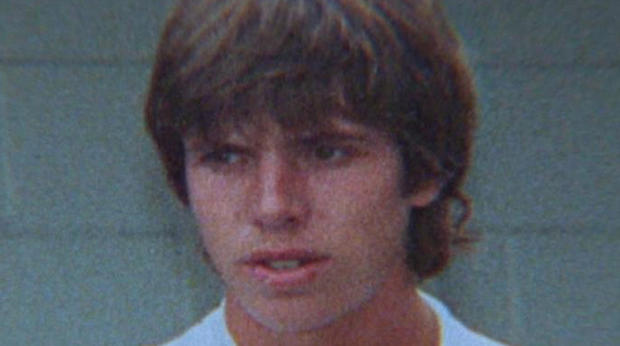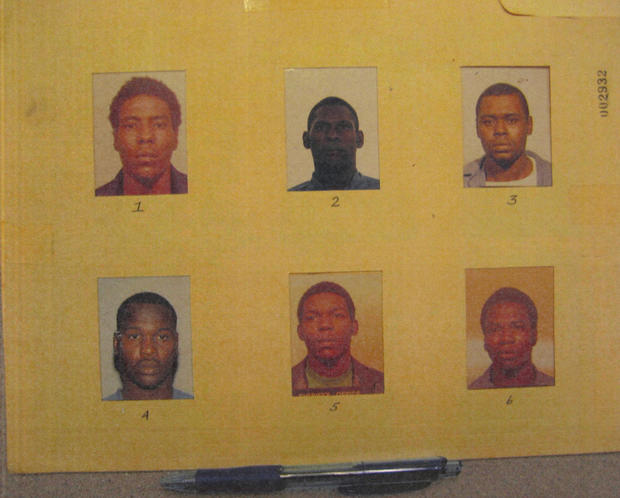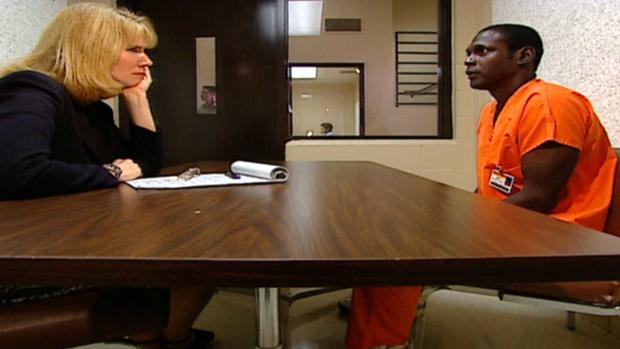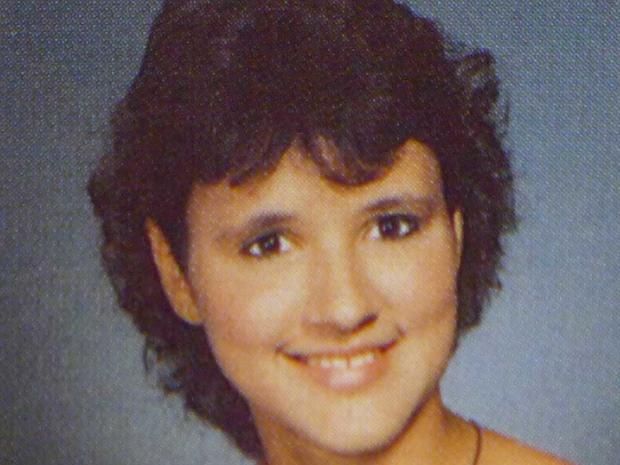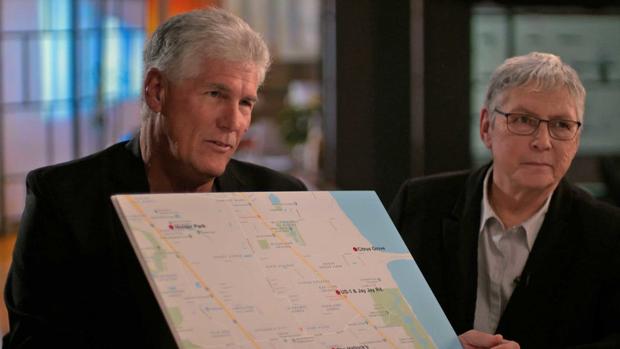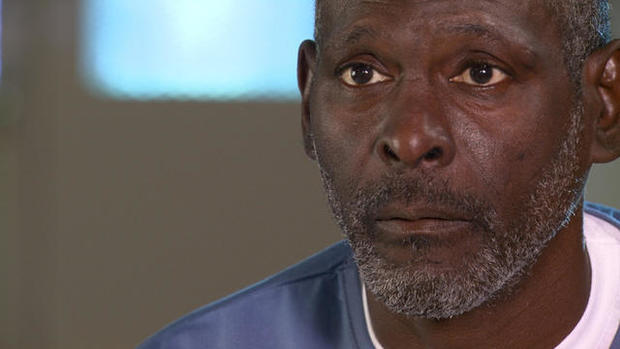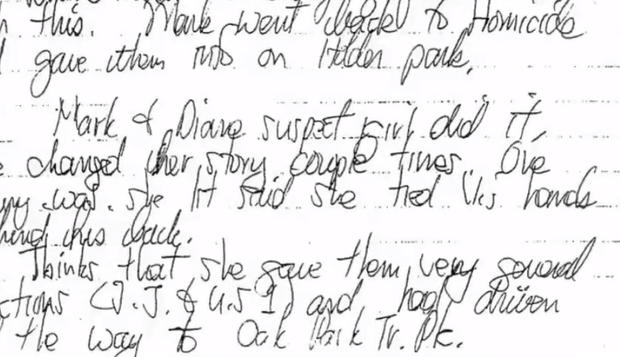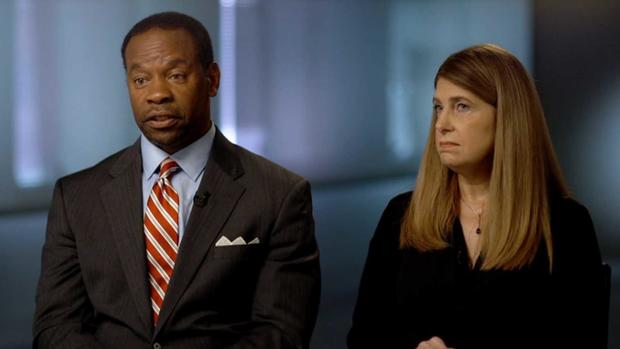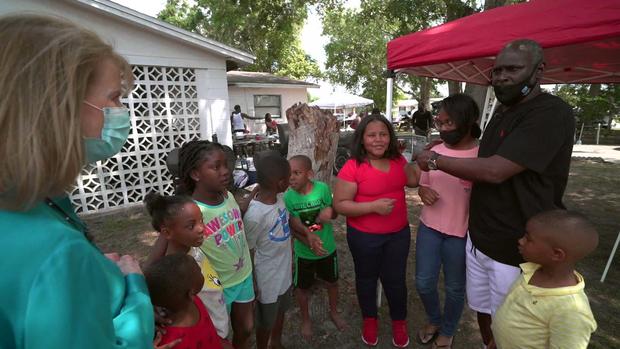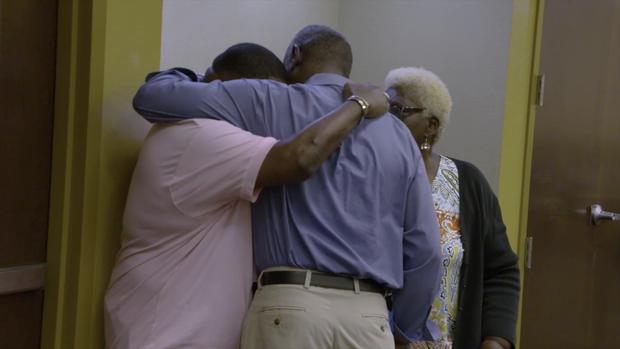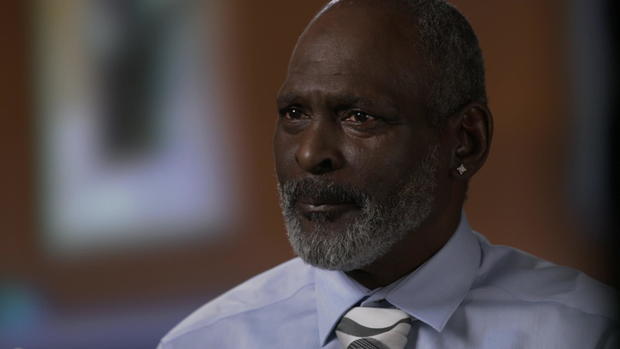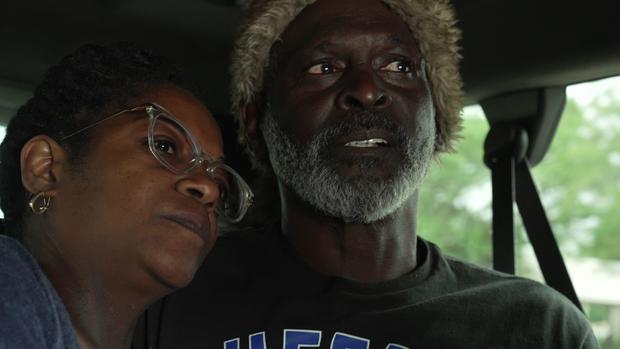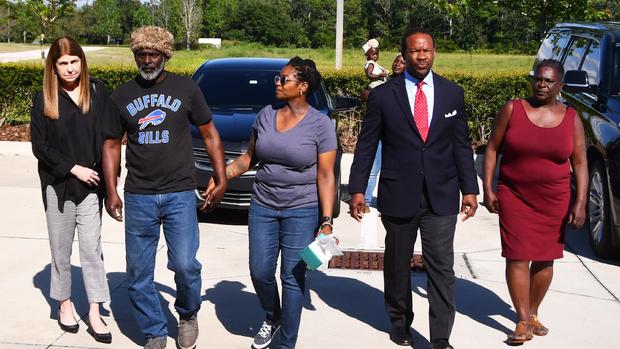Convicted and imprisoned for 32 years, a federal judge ruled Crosley Green had been wrongfully convicted of a 1989 murder in Florida. But now, two years after his release, the Florida grandfather was ordered back to prison. “48 Hours” correspondent Erin Moriarty sits down with Green on what could be his last day outside prison walls and takes a look back at his fight for freedom and what’s next.
“48 Hours” has been covering the questionable conviction of Crosley Green for 24 years.
Green’s attorneys say that race was a factor from the beginning.
Keith Harrison | Defense attorney: The evidence that Crosley Green is innocent is literally overwhelming.
Crosley’s ordeal began in April of 1989, when Charles Flynn, better known as Chip, was found shot in a Florida citrus grove. He had been with his ex-girlfriend Kim Hallock that night. She told investigators that they had been robbed and hijacked by a black man in Holder Park as they sat in Chip’s truck a little after 11 p.m.
KIM HALLOCK TO DETECTIVES : I told Chip “there’s a Black guy on your side” and he rolled up the window real quick.
Twenty minutes later, Hallock says, Chip stepped out of the truck, and she heard him say “Hold on, man.”
DETECTIVE: Did you see that the – the Black male was armed at that time?
KIM HALLOCK: Yes, I did.
KIM HALLOCK: Chip had a gun in his glove box. I took the gun out of the glove box and stuck it under some jeans that were next to me.
She first told police the man had her tie Chip’s hands with a shoelace. She later told police the man ordered her to hand over money from Chip’s wallet, and then with everyone in the truck, she says the assailant drove them to the orange grove steering, shifting gears, and somehow holding a gun on them all at the same time.
Kim Hallock told police that when they got to the grove, the man yanked her out of the truck and then Chip — his hands still tied behind his back—somehow managed to get a hold of his gun that Kim had hidden on the truck seat.
KIM HALLOCK : He leaned out of the truck and somehow shot at the guy and the guy stepped back, Chip dove out of the truck, I jumped in the truck … and I heard about five or six gun shots.
She said she then drove to a friend’s home for help. Sheriff’s Deputy Mark Rixey and Sgt. Diane Clarke were the first two officers on the scene.
Erin Moriarty: Kim Hallock says that this assailant took both Chip and Kim to this citrus grove at 12:10. And yet, you’re not dispatched til 1:13.
Diane Clarke | Retired Brevard County sergeant: It’s over an hour.
Keith Harrison: There is approximately an hour that is missing and unexplained.
Erin Moriarty: How crucial was that time that night?
Mark Rixey | Former Brevard County deputy: Matter of life and death.
Diane Clarke: Why is she not stopping some place and making that phone call?
Erin Moriarty: Where could she have called?
Diane Clarke [points to map]: Right here.
Mark Rixey [points to map]: From a payphone … I think there was three along the way. … A convenience store, convenience store. And the hospital is right there.
The directions Hallock gave were so vague that even after Clarke and Rixey were dispatched, it took another 30 minutes to find Chip.
Mark Rixey [points to map]: I get the call at 1:13. I respond to this area. There’s nothing there. … Had to notify my dispatch … get better directions. … I drive to this new area here, where they informed me to go. Again, there’s nothing there.
Erin Moriarty: Why then were you first sent to the wrong location?
Mark Rixey: That’s a good question.
Diane Clarke: ‘Cause she didn’t tell us where to go. She gave the wrong direction.
Sgt. Clarke ended up sending another deputy to pick up Hallock so she could better guide them.
Diane Clarke: She wouldn’t get out the car.
Mark Rixey: We say, “Can you show us where?” “Nope. Not going down there”
Erin Moriarty: What did that say to you, what did you think?
Diane Clarke: There’s something wrong … something is not ringing true … I would want to know, “Is he OK?”
They found Chip laying on his stomach with his hands tied behind his back, bleeding from a single gunshot wound to his chest.
Diane Clarke: He was in pain, but … I seriously thought he’d be OK.
Mark Rixey: First words out of his mouth were “Get me outta here. I wanna go home.”
Erin Moriarty: Did he mention anything about an assailant?
Mark Rixey: Nope.
Diane Clarke: No.
Erin Moriarty: Did he mention anything about being robbed.
Mark Rixey and Diane Clarke: No.
Erin Moriarty: Did he mention anything about being kidnapped?
Mark Rixey and Diane Clark: No.
Mark Rixey: I’m thinking, “what’s going on here?”
Diane Clarke: My feeling about it at the time and still is … that he was protecting her.
Chip Flynn stopped breathing twice as they waited for an ambulance. Sgt. Clarke tried to save his life.
Diane Clarke: He didn’t have to die.
Charles Flynn: There wasn’t anything he didn’t like to do.
Chip’s parents Charles and Peggy Flynn, now both deceased, rushed to the orange grove when they got the word Chip had been hurt. But police wouldn’t let them near the scene.
Peggy Flynn: I should have been able to go back to see him.
Chip’s parents Charles and Peggy Flynn, now both deceased, rushed to the orange grove when they got the word Chip had been hurt. But police wouldn’t let them near the scene.
Peggy Flynn: I should have been able to go back to see him.
The Flynns, who spoke with “48 Hours” in 1999, were shocked to learn that Chip had been with Kim Hallock that night. Chip had a new girlfriend.
Charles Flynn: That was all he talked about. He didn’t mention Kim anymore or anything.
Chip’s parents said Kim had become too possessive and overbearing.
Charles Flynn: Chip liked his freedom. And she wanted him to be with her all the time.
Hallock was upset about the breakup, according to Chip’s friend David Stroup, who also spoke with “48 Hours” in 1999.
David Stroup: I do remember that he just — that she didn’t want to let go.
And it was Stroup’s home where Kim Hallock went for help.
David Stroup: I wondered why she came to my place, as opposed to just stopping at the first potential telephone … you know, even a home with a light on or anything if it, you know … So, it’s always bothered me.
Kim Hallock was not and has never been a suspect. Homicide detectives from Brevard County Sheriff’s Office seemed to take her at her word, despite her delay in calling for help and her inability to describe the assailant very well.
KIM HALLOCK : I really didn’t even get a real good look at him. I was really scared.
Investigators claimed that almost immediately, they got a tip that a small-time drug dealer, Crosley Green, was involved. He had recently been released from jail.
Diane Clarke: The description that she had given for the sketch didn’t match him.
They showed Hallock a photo lineup, and Kim chose #2, Crosley Green.
BCSO
Keith Harrison: His picture is smaller and darker than any of the other pictures. And it’s right in, you know, what is often referred to as the bullseye point of a photo array.
Crosley Green admits he was no angel, but he had no history of violent crime.
Diane Clarke: I think he was just an easy pick. … “We’re gonna put somebody in jail for this.”
Green was arrested and charged with kidnapping, robbery and murder despite no direct evidence linking him to Chip’s shooting.
Keith Harrison: There were no fingerprints of Crosley Green or any third person on the – the truck … Not one single fingerprint.
WHERE’S THE EVIDENCE?
Keith Harrison: There was no case against Crosley Green … There was no case. It was a one witness ID case.
In August 1990, Crosley Green went on trial for the murder of Chip Flynn. The case hinged on the testimony of Kim Hallock, the state’s star witness who identified Green as the “Black” man who attacked the couple.
Keith Harrison | Defense attorney: That’s the weakest kind of case … where the only evidence you have is somebody said, “that guy did it.”
The state claimed there were also shoeprints found at Holder Park. Prosecutor Christopher White, now retired, said a dog followed the scent of those prints to the vicinity of a house where one of Green’s sisters lived. White spoke with “48 Hours” in 2015.
Christopher White: The shoe impressions were followed … from the site where the truck was parked … supporting what Kim said about there being a third person there, a Black male, who abducted them and did these things.
Those shoeprints, however, were never linked to Crosley Green. But the prosecution also had three witnesses — all with criminal problems of their own — who claimed Crosley confessed. One was Crosley’s own sister, Sheila.
The defense argued that Crosley couldn’t have killed Flynn because he had an alibi.
Crosley says he was seen at the time of the murder by multiple witnesses at a party two miles away.
But his former attorney only called one to testify. And on September 5, 1990, an all-White jury convicted Crosley Green of kidnapping, robbery and murder. He was sentenced to die in Florida’s electric chair.
CBS News
Erin Moriarty [1999]: Hi Crosley, I’m Erin Moriarty with CBS. [they shake hands]
Moriarty first met Crosley Green in 1999.
Erin Moriarty: What’s it like being here on death row?
Crosley Green: It’s hell to me, because I’m here for a crime I didn’t commit.
A team of lawyers from Crowell & Moring led by Keith Harrison and Jeane Thomas took Crosley’s case pro bono. They say jurors never heard the real story.
Jeane Thomas | Defense attorney: When you look at the all the facts … you see that the state wanted to achieve a certain result. … And they manufactured evidence. They coerced witnesses … to lie.
Even before the trial, Kim Hallock’s account had serious inconsistencies. She told police that the assailant had managed to steer Chip’s truck, shift gears, all while holding a gun on them. And, yet, she told Chip’s parents a very different story.
Charles Flynn: She was having to shift the gears for him. He would just mash the clutch and she would shift the gears. He was making her do that.
Kim changed other parts of her story as well. According to a police report from the night of the shooting, she told a deputy the assailant told her to tie Chip’s hands.
But just hours later, in her taped interview: “The Black male was tying Chip’s hands.”
Erin Moriarty: … those inconsistencies, would that have concerned you?
Christopher White: We’re talkin’ about who tied him?
Erin Moriarty: Yes, and who shifted the truck.
Christopher White: Of course, it would if she was inconsistent, any inconsistencies.
And yet, another serious inconsistency: Kim’s description of the assailant’s gun matched a semi-automatic. She said that when she drove away, leaving Chip at that grove, she heard five to six gunshots. But no shell casings were recovered at the scene, and the only bullet found was the one that killed Chip.
BCSO
Erin Moriarty: Your own expert said … that, in fact, the bullet found in Chip Flynn could have come from his own gun. Did you find another weapon?
Christopher White: Well, no. …
Erin Moriarty: Did you ever find another shell casing to match that weapon?
Christopher White No, and we wouldn’t if, in fact, he was shooting a revolver. You understand —
Erin Moriarty: But in fact, did you find any other bullet holes?
Christopher White: Bullet holes? Not that I’m aware of.
KIM HALLOCK : Just about then, Chip … his hands were behind his back, he leaned out of the truck and somehow shot at the guy.
But that statement was contradicted by the evidence. Investigators found no gunshot residue on Chip Flynn’s hands.
Mark Rixey: The fact that his … did not show any gunshot residue contradicts her story. … And I totally don’t believe someone could actually jump outta that truck and shoot a gun behind their back with their hands tied anyway.
Christopher White: … when you look at this case, it is all circumstantial. I would love to have had a stronger case. But it is what it is.
As for those shoeprints at the park, criminalist Lisa DiMeo, who helped Crosley’s defense team, told “48 Hours” that diagram shown at trial contradicts the actual crime scene video.
CRIME SCENE VIDEO: These shoeprints after proceeding west will then continue on around just to the outside of this fence …
If these were the tracks of the assailant, they should end where the truck was parked. But, in fact, DiMeo says they continue past the truck, along the fence, and appear to leave the park.
Erin Moriarty: How can they belong to the assailant if in fact he got in the truck back here? They couldn’t.
Lisa DiMeo: No, no they couldn’t.
The trail of prints leaving Holder Park is missing from the diagram.
Erin Moriarty: This diagram supports Kim Hallock’s story. But this diagram doesn’t match the evidence at the scene?
Lisa DiMeo: Correct. … This was necessary to make her story fit.
What’s more, every one of the three witnesses who testified that Crosley Green confessed – recanted after trial.
Keith Harrison: There’s a pattern that supports the fact that these folks were coerced.
Erin Moriarty: When a sister testifies against her own brother and says he confessed … it’s hard to believe that could be coerced.
Keith Harrison: Absolutely. She recanted almost immediately.
“48 Hours” tracked down Sheila Green in 1999.
Erin Moriarty: What did they say would happen if you didn’t testify against your brother?
Sheila Green: I would never see my kids again.
She told us she had no choice but to lie on the stand.
Erin Moriarty: Did Crosley ever tell you that he killed Chip?
Sheila Green: I never even talked to Crosley. He never told me that. … Basically, they told me that this was my last chance to help myself because I was already convicted.
Erin Moriarty: But this is your own brother, Sheila.
Sheila Green: He will understand.
Erin Moriarty: You think he will?
Sheila Green: Yes, he will, he knew I — [cries].
FIRST RESPONDERS SPEAK OUT
Kenneth Nunn: Florida had a long history of being engaged in slavery, in the plantation economy … that has passed itself on to the criminal justice system here in the state.
Kenneth Nunn, a now-retired professor at the law school at the University of Florida says the odds were stacked against Crosley Green in that Florida courtroom.
Kenneth Nunn: I would say that Crosley Green’s case is a miscarriage of justice.
Keith Harrison | Defense attorney: If you read the … the trial transcript … the prosecutor was using race to fill the gaps in the evidence.
During trial, the defendant’s race was referred to 140 times.
KIM HALLOCK : I told Chip “there’s a Black guy on your side.”
Kenneth Nunn: … and she accuses a Black person of committing this crime. Who are they gonna believe?
And what has defined this case from the very beginning is that Kim Hallock was treated as a victim, never as a possible shooter.
Mark Rixey | Former Brevard County deputy: Everybody on the scene is a suspect until they’re not. … Every single person is tested for gunshot residue … that’s not what happened here.
To this day, first responders Diane Clarke and Mark Rixey question why Brevard County detectives failed to do even a basic investigation of Kim Hallock.
Erin Moriarty: Kim Hallock was taken in and questioned at 4:30, but not recorded until 8:20 … What does that say to you?
Diane Clarke | Retired Brevard County sergeant: Well, she had time to get her story the way she wanted it. … She was not a suspect.
Erin Moriarty: Did it ever occur to you or anyone else that maybe Kim … Hallock wasn’t telling the truth?
Christopher White | Former prosecutor: Well, of course it did.
Erin Moriarty: Then why wasn’t she ever investigated? Why was she never a suspect?
Christopher White: What was, what was supposed to be … What do you mean?
Erin Moriarty: No G.S.R. taken of her hands? Why not?
Christopher White: I don’t know if there was or wasn’t at this point—
Erin Moriarty: There wasn’t. … Why weren’t pictures taken of her hands, her arms, to see if she had any injuries?
Christopher White: I guess they could’ve done more examination. I’ll give you that, OK?
Crosley Green’s lawyer Keith Harrison finds it mind-boggling.
Keith Harrison: Chip Flynn had broken up with Kim Hallock. He was seeing another woman. … Kim Hallock was very upset about that. … That’s the oldest motive in the book.
Erin Moriarty: Jealousy?
Keith Harrison: Jealousy.
Still, White took Kim Hallock at her word.
Christopher White: You’ve gotta understand. It’s kind of a small community here in Titusville. Kim Hallock lived … at the, in the area where I lived.
Christopher White: I don’t see how there’s anything here concrete to tell anybody that Kim Hallock lied.
But there were those obvious red flags with her story. There was no moon on the night Chip Flynn was shot; it was completely dark in that orange grove.
Keith Harrison: Based on her testimony, she said she didn’t get a really good look at him.
Yet Kim Hallock chose Green out of a photo lineup — a flawed lineup. Professor Nunn says that is no longer allowed under Florida’s current laws.
Kenneth Nunn: You can’t tell the witness that the suspect is in the batch … and that happened in this case … you have to make sure that the photograph matches all the other photographs … his head is smaller than the other ones … so he stands out.
Erin Moriarty: Would you do this today?
Christopher White: Well, no, no. Ideally, I would not.
Erin Moriarty: Could she have picked the wrong person?
Christopher White: I don’t think she did, you know? … Was she guessing more than she was sure? I couldn’t tell you for sure.
Christopher White: That still leaves you with the issue of whether or not it’s Crosley. And you have arguments pro and con about that. But the one thing I’m sure of, based on the evidence in this case, it wasn’t Kim Hallock.
Mark Rixey: She was the only other one there. Who else woulda done it? … the only way all the facts are reconciled is if she shot him.
CBS News
Mark Rixey: I told everybody I ran into who had any interest in it … I thought she did it. I told the homicide sergeant. I told the homicide investigator.
And four months after the shooting, both Rixey and Clarke met with prosecutor Christopher White. They wanted to make sure he knew of their suspicions of Kim Hallock.
Erin Moriarty: And how did Chris White take that information?
Mark Rixey: He was dismissed — dismissive.
Diane Clarke: I said to him … “She is involved … and I don’t believe it’s the person you arrested.” … I never heard anything else about it afterwards.
Mark Rixey: I think that they got into an argument, she pulled the gun out of the glove box, and either intentionally or unintentionally shot him … They freak out … “I don’t want to get into trouble. We gotta come up with a story. … Let’s make up this story.”
Erin Moriarty: Why didn’t you then take their word seriously?
Christopher White: I reviewed all the evidence that we had with that hypothesis in mind. … do they give me cause to believe that Kim Hallock may have committed this murder? … my answer is no.
Erin Moriarty: You’re that sure that Crosley Green is innocent?
Mark Rixey: I would bet my life on it, yes.
But in 2000, 11 years after Chip Flynn’s murder, the state claimed it had more evidence against Green: two tiny body hairs allegedly found in Flynn’s truck. They tested them for DNA.
Crosley Green [2000]: Matter of fact, I wanted ’em to test it … I hadn’t been in that truck, I never been in that truck.
Christopher White: There was sufficient DNA there to obtain a result using MTA DNA.
BCSO
That DNA – mitochondrial— cannot be used to identify a specific person – it can only identify broad family relations. And Crosley Green could not be excluded from that group.
Jeane Thomas | Defense attorney: It’s not a match. … the mitochondrial DNA test cannot definitively say, “This DNA is this individual’s DNA.” … Crosley’s maternal relatives, for example, would be in this group that is not excluded.
In fact, Crosley’s brother O’Connor believes the hairs could be his. He happened to be a friend of the original owner of the truck.
O’Connor Green: It’s possible. ‘Cause I drove the truck kinda regular. I’m not tellin’ I drove the truck one or two time. I done drove the truck several time.
Erin Moriarty: Are you at all troubled by the fact that … Crosley Green could not be eliminated?
Mark Rixey: That’s nothing. That’s not evidence, that is not evidence … it does not tie him specifically to that truck.
Erin Moriarty: You have that one hair that could’ve come from someone else, his brother.
Christopher White: Uh-huh.
Erin Moriarty: Is there any other physical evidence, anything, that connects Crosley Green to this case?
Christopher White: Well I — I guess the simple answer to that is no.
CBS News
In 2009, after 19 years facing execution on death row, Crosley Green’s attorneys won a major victory: because of an error in sentencing, Green was taken off death row.
Crosley Green: I felt real good at that time … But I know I have another hundred yards to go.
But Crosley Green’s request for a new trial was denied. Even though some of the evidence was now in question and all those witnesses who testified against him said they lied on the stand.
Erin Moriarty: Have you ever had a case where three witnesses have recanted and lied? Have you ever had a case? Three?
Christopher White: You know, I never have.
Erin Moriarty: That doesn’t trouble you?
Christopher White: Not coming from those people with those ties to the Green family and the Green family being what it is, no. It doesn’t trouble me a great deal.
But in an odd twist of fate, Christopher White provided just what Crosley Green’s defense team had been waiting for.
Keith Harrison: I was shocked … I knew immediately that this was a game changer.
CRUCIAL EVIDENCE UNCOVERED
Crosley Green [2020]: I’m ready to go home. And hopefully I get that chance to go home.
Crosley Green [2020]: I’ve been without my family for quite some time now.
Crosley Green was just 19 when his parents died and he assumed the role of “Papa” to his large family. It is why Crosley’s murder conviction was so deeply felt by his oldest child, Shuma, his brother O’Connor, and sisters Shirley and Degrah.
O’Connor Green: I worry about him a lot … And … it’s breakin’ the family; it’s breakin’ the family down.
Shuma was 16 and his brother Gaston was 6 when Crosley was sentenced to death.
Shuma Green: It damaged us…. I got rebellious. I just went to gettin’ in trouble. No sense of direction … ‘Cause my dad was gone.
Crosley Green: I never was with my sons when they grew up, you know … And I got grandkids now … I don’t know how much time I got left on earth myself. But the little time I will have left, if I’m out there, it would be with them.
But Crosley Green will never be able to make up lost time with two of his sisters; they died while he’s been in prison.
Crosley Green: Brenda and Tina.…That’s been tough. That’s been tough. … they have been with me all up till the time they died.
Erin Moriarty: You miss them?
Crosley Green: Yeah [his eyes well with tears].
As for Sheila, the sister who helped put him on death row? He forgave her years ago.
Erin Moriarty: Does she feel a lot of guilt?
Crosley Green: Of course, she do. But that’s my sister and I want her to know that I love her and — no matter what. I’m not angry at her. OK?
With the witness recantations, the only person who still connects Crosley to the crime is Kim Hallock.
Erin Moriarty: As you sit here today, do you believe Crosley Green is the man who shot Chip Flynn?
Christopher White: Yes, I do. Yes, I do.
But, as it turns out, Christopher White made a decision in 1989 that would ultimately turn the tide for Crosley Green.
KEITH HARRISON [reading White’s notes]: “Mark and Diane suspect the girl did it. She changed her story a couple of times.”
BCSO
White took these notes after his meeting with Mark Rixey and Diane Clarke when they told him their suspicions about Kim Hallock.
KEITH HARRISON [reading White’s notes]: One thing was, “she tied his hands behind his back. She never asked how the victim was while at the homicide. She wouldn’t go down there to the scene. Why wouldn’t the guy say who shot him?”
White never turned those notes over to Crosley’s original lawyer.
Keith Harrison: This is the evidence of innocence that was hidden … by the prosecutor.
Erin Moriarty: What was your reaction when you first read those notes?
Keith Harrison: I was shocked. … I really couldn’t believe it.
Keith Harrison: They can’t just hide that evidence … They can’t cover it up. They have to disclose it to the defense.
CBS News
Defense attorney Jeane Thomas says those notes — which included inconsistencies in Kim Hallock’s story — would have been crucial at trial.
Jeane Thomas: It goes … to the heart of the defense theory of the case. That there was no Black man at the scene of this crime … That it was these two teenagers, that there was an accident … And then there was a story that was made up after the fact.
Keith Harrison: …those notes … would have had a tremendous impact on the case.
And for that reason, in July 2018, a federal judge ruled that, by withholding those notes, prosecutors violated Crosley Green’s right to a fair trial. His conviction was overturned.
Jeane Thomas: It was a miracle that finally there was a court that … said, “Yes, his constitutional rights were violated.”
Erin Moriarty: When his conviction was overturned, what did you think would happen?
O’Connor Green: Man, I thought my brother’d be home.
But Crosley didn’t come home because the state appealed, arguing that the notes that prosecutor White withheld wouldn’t have changed the outcome of the original trial. Crosley was held in prison waiting for the U.S. Court of Appeals to decide.
Keith Harrison: Honestly, I did not think it would take this long.
But then the coronavirus invaded the prison where Crosley Green was held. His situation became even more precarious after he was diagnosed with latent tuberculosis. In March 2021, Crosley’s attorneys filed a motion for his immediate release.
Crosley Green (2021): I can’t tell you what I was thinking or what I saw or how I felt. … I was just looking around wondering, is this real? You know, at one point now I really wondered, is this real?
ORDERED BACK TO PRISON
Now that Crosley Green is home, his very large and loving family has descended upon him. Everybody wants a piece of the man they know as “Papa Green.”
Crosley Green: I thought maybe it would be the kids that really wanna be with me or wanna talk with me. The grownups be … making them kids get out the way…. They pushed the kids to the side. They wanna be first.
CBS News
Crosley has a lot of catching up to do. So many relatives weren’t even born when he went to prison.
Crosley Green: If it wasn’t for my family, I — I wouldn’t be here. … My sister, Celestine … she always told me, “Don’t give up. … Your day’ll come.” … I used to always say, “All right, girl, when I get out, we’re gonna do things,” you know, but that day never came. She died …
Crosley’s sister, Celestine, is buried in a cemetery just down the road from where he’s now staying, but he can’t visit her grave —or most anywhere else — without special permission from his probation officer.
Crosley Green: I was told … I couldn’t go to the mailbox.
He’s free, but right now, can’t venture beyond his brother-in-law’s property line.
Crosley calls it his “12 yards of freedom”— and showed Moriarty his new jailer.
Crosley Green: Here it is right here. This ankle bracelet right here.
Jeane Thomas: It’s challenging for him. … Crosley has many, many grandchildren, most of whom he’s — he’s never met. … He wants to take them to a park and go fishing, and teach them how to fish … and you know, sit under a tree — and tell stories. …And he can’t, he can’t do that.
At least not until the U.S. Court of Appeals hands down its decision.There is a chance the court will side with the state, reinstate Crosley’s conviction and send him back to prison
But less than a year later, in March 2022, the U.S. Court of Appeals came back with a decision that caught everyone off guard.
The court ruled that those notes Christopher White failed to turn over to Crosley’s defense wouldn’t have changed the outcome of his trial. His conviction was reinstated.
Keith Harrison: That was pretty crushing. … we think … They got it wron.g
Crosley’s last hope: to ask the U.S. Supreme Court to take his case. But in February 2023, the attorneys gathered the Green family together to break the bad news.
Keith Harrison (at the family meeting): The Supreme Court is not going to hear our case.
Crosley has run out of legal options, which means he has to go back to prison. His sister, Shirley, took the news hard.
Shirley Green:(at the family meeting) Y’all going to send him to prison for a crime he didn’t commit? Y’all going to take him away from his family again? … You took him 33 years.
Keith Harrison: There was a fair amount of anger.
Shirley Green: We do. My brother continues to have to go through this.
Keith Harrison: It was very emotional. … It was raw.
Shirley Green: It’s not right.
Keith Harrison: And there was a lot of deep, deep sadness. You could almost feel like the family was kinda coming apart right — right there in front of you.
Shirley Green: It failed us. The system failed us. … He shouldn’t have even go back to jail. [breaks down crying].
Shuma Green: We just got dropped in the last round.
Crowell and Moring
For Crosley’s son, Shuma, the thought of losing his father again was inconceivable.
Shuma Green (at meeting, very emotional): You ain’t the only one doing time, we are doing time right with you. … it’s a family thing and it’s now torn apart again.
Jeane Thomas: They just miss him terribly. He just is such an important … patriarch among that family — a role model. But he keeps that family together.
Crosley Green (at the family meeting): Because I can feel what they feel.
And in that difficult moment, Crosley assumed the role of patriarch again.
Crosley Green (at the family meeting, cries): You have showed me a lot since I’ve been home. … But we going to get this together. We’re going to be all right if we stay together. … I can’t be hurt because I — I still got faith. I got the Lord on my side. I’m happy. I am happy. [To Shuma] Love you baby.
On his last weekend as a free man, Crosley seemed almost hopeful.
CBS News
Crosley Green: I’m a religious person. … And I have a lot of faith and trust. And most importantly … I still believe in the system. … I don’t have no hatred. I don’t have no sadness. … I can’t dwell on that. … Couldn’t sleep, I would start getting angry … And that’s not me.
Crosley has made the most of the time he spent at home.
Crosley Green: The last year has been a remarkable year. … I got a job I never missed a day on.
He made high-tech metal parts and left a big impression. Crosley says his coworkers called him “PPE.”
Erin Moriarty: And what does “PPE” stand for?
Crosley Green: Pure, Positive, Energy. That’s what it stand for.
Crosley also fell in love and got engaged. His fiance, Katherine Spikes.
Crowell & Moring and Nerissa Johnson
Kathy Spikes: When we did meet, it was butterflies but at the same time it was excitement.
Erin Moriarty: How soon did you know that this was the guy you wanted to be with?
Kathy Spikes: After our first phone call. … What man these days sit on the phone for six hours? … I think just the compassion that he showed me, that it was just the simple — the sound and tone of his voice that made everything like, “Oh, my God, you could make everything all right for me.”
Erin Moriarty: Does it make it tough to go back?
Crosley Green: Yes and no. No, because I’ve always tried to prepare her for the worst, like myself … let’s just say that I do not get that miracle tomorrow, but it’s coming, you know? I’m not gonna have to tell her goodbye for infinity. I’m gonna always love her
On his last Sunday, just like every other Sunday since he’s been out, Crosley went to church. This time, he said goodbye.
Crosley Green (addressing church members): : Do not worry. And this is what I’ve been trying to tell my sisters, my family. Do not worry. … I see tears fall from there, it bothers me … I’m OK, I can do this. Let me do this. Let me show you all. Be strong with me. I’m in God’s hands. I am in God’s hands!
On Monday, April 17, 2023 — two years after Crosley’s conditional release, he said a goodbye to his family. He left each one of them with a few words of wisdom —
Crosley Green: I love you. I want you to continue doing what you been doing. … We have to take one day at a time. … Everything going to be OK.
— on what could be his last day outside the prison walls.
Crosley Green: I love you all man … listen, listen you all be strong.
Then he joined his fiancé Kathy and attorneys for the drive to the corrections center.
Crosley Green: Everything going to be OK.
Crowell & Moring
Crosley Green: She’s been right there by my side.
More family members arrived.
Crosley Green: Last two years been some of the greatest time I ever had … All these memories I got — those are my memories. … When I go back, they’ll still be my memories.
Malcolm Denemark/Pool photo
Crosley Green: I think I’m gonna be free soon. … And it ain’t about the case. It’s about me. … It’s about a human being that wants his freedom, wanna be able to be around his grandkids, his little nieces, nephews, his brothers and sisters, family and friends, you know? This is what this is about.
Crosley Green: They need me. I need them too. But they need me more.
Crosley Green’s only remaining options for freedom are to seek parole or clemency.
Produced by Asena Basak. Michael Loftus and Shaheen Tohki are the associate producers. Charlotte A. Fuller is the development producer. Grayce Arlotta-Berner and Gregory F. McLaughlin are the editors. Patti Aronofsky is the senior producer. Nancy Kramer is the executive story editor. Judy Tygard is the executive producer.
Stay connected with us on social media platform for instant update click here to join our Twitter, & Facebook
We are now on Telegram. Click here to join our channel (@TechiUpdate) and stay updated with the latest Technology headlines.
For all the latest Education News Click Here

